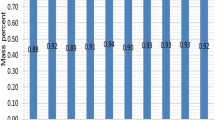Abstract
A comprehensive study of the most commonly used jet fuels (i.e., Jet A-1 and JP-8) was performed to properly assess potential contamination of the subsurface environment from a leaking underground storage tank occurred in an airport. The objectives of this study were to evaluate the concentration ranges of the major components in the water-soluble fraction of jet fuels and to estimate the jet fuel–water partition coefficients (K fw) for target compounds using partitioning experiments and a polyparameter linear free-energy relationship (PP-LFER) approach. The average molecular weight of Jet A-1 and JP-8 was estimated to be 161 and 147 g/mole, respectively. The density of Jet A-1 and JP-8 was measured to be 786 and 780 g/L, respectively. The distribution of nonpolar target compounds between the fuel and water phases was described using a two-phase liquid–liquid equilibrium model. Models were derived using Raoult’s law convention for the activity coefficients and the liquid solubility. The observed inverse, log–log linear dependence of the K fw values on the aqueous solubility were well predicted by assuming jet fuel to be an ideal solvent mixture. The experimental partition coefficients were generally well reproduced by PP-LFER.


Similar content being viewed by others
References
Abraham MH (1993) Scales of solute hydrogen-bonding: their construction and application to physicochemical and biochemical processes. Chem Soc Rev 22:73–83
Abraham MH, Andonian-Haftvan J, Whiting GS, Leo A, Taft RS (1994) Hydrogen bonding. Part 34. The factors that influence the solubility of gases and vapours in water at 298 K and a new method for the determination. J Chem Soc Perkin Trans 2:1777
Abraham MH, Poole CF, Poole SK (1999) Classification of stationary phases and other materials by gas chromatography. J Chromatogr A 842:79–114
Abraham MH, Ibrahim A, Zissimos AM (2004) Determination of sets of solute descriptors from chromatographic measurements. J Chromatogr A 1037:29–47
American Petroleum Institute (1985) Laboratory study of solubilities of petroleum hydrocarbons in groundwater. API Publication No. 4395, API, Washington
Arey JS, Gschwend PM (2005) Estimating partition coefficients for fuel-water systems: developing linear solvation energy relationships using linear solvent strength theory to handle mixtures. Environ Sci Technol 39:2702–2710
Banerjee S (1984) Solubility of organic mixtures. Environ Sci Technol 18:587–591
Chen CS, Delfino JJ, Rao PSC (1994) Partitioning of organic and inorganic components from motor oil into water. Chemosphere 28:1385–1400
Chen CS, Lai Y-W, Tien C-J (2008a) Partitioning of aromatic and oxygenated constituents into water from regular and ethanol-blended gasolines. Environ Pollut 156:988–996
Chen CS, Lai Y-W, Tien C-J (2008b) Partitioning of polynuclear aromatic hydrocarbons into water from biodiesel fuel mixtures. Environ Chem 5:435–444
Cline PV, Delfino JJ, Rao PSC (1991) Partitioning of aromatic constituents into water from gasoline and other complex solvent mixtures. Environ Sci Technol 25:914–920
Code of Federal Regulations (2012) Methods for organic chemical analysis of municipal and industrial wastewater. Method 624—purgeables. Title 40, Part 136, Appendix A. Washington
Corporation Chevron (2006) Aviation fuels technical review. Chevron Products Company, Houston
Endo S, Schmidt TC (2006) Prediction of partitioning between complex organic mixtures and water: application of polyparameter linear free energy relationships. Environ Sci Technol 40:536–545
ExxonMobil Aviation International (2008) World jet fuel specifications with avgas supplement, 2008th edn. ExxonMobil Aviation International, Leatherhead
Goss K-U, Schwarzenbach RP (2001) Linear free energy relationships used to evaluate equilibrium partitioning of organic compounds. Environ Sci Technol 35:1–9
Lane WF, Loehr RC (1992) Estimating the equilibrium aqueous concentrations of polynuclear aromatic hydrocarbons in complex mixtures. Environ Sci Technol 26:983–990
Lee LS, Hagwell M, Delfino JJ, Rao PSC (1992a) Partitioning of polycyclic aromatic hydrocarbons from diesel fuel into water. Environ Sci Technol 26:2104–2110
Lee LS, Rao PSC, Okuda I (1992b) Equilibrium partitioning of polycyclic aromatic hydrocarbons from coal tar into water. Environ Sci Technol 26:2110–2115
Mezher N, Rathbun WE, Wang H, Ahmad F (2013) Chemical composition and screening-level environmental contamination risk of bioderived synthetic paraffinic kerosene (Bio-SPK) jet fuels. Energy Fuels 27:3830–3837
Mukherji S, Peters CA, Weber WJ (1997) Mass transfer of polynuclear aromatic hydrocarbons from complex DNAPL mixtures. Environ Sci Technol 31:416–423
Peters CA, Luthy RG (1993) Coal tar dissolution in water-miscible solvents: experimental Evaluation. Environ Sci Technol 27:2831–2843
Peters CA, Luthy RG (1994) Semiempirical thermodynamic modeling of liquid-liquid phase equilibria: coal tar dissolution in water-miscible solvents. Environ Sci Technol 28:1331–1340
Reckhorn SBF, Zuquette LV, Grathwohl P (2001) Experimental investigations of oxygenated gasoline dissolution. J Environ Eng ASCE 127:208–216
Rodgers RP, Blumer EN, Freitas MA, Marshall AG (1999) Jet fuel chemical composition, weathering, and identification as a contaminant at a remediation site, determinated by Fourier transform ion cyclotron resonance mass spectrometry. Anal Chem 71:5171–5176
Schmidt TC, Kleinert P, Stengel C, Goss K-U, Haderlein SB (2002) Polar fuel constituents: compound identification and equilibrium partitioning between nonaqueous phase liquids and water. Environ Sci Technol 36:4074–4080
Torres-Lapasió JR, Ruiz-Ángel MJ, García-Álvarez-Coque MC, Abraham MH (2008) Micellar versus hydro-organic reversed-phase liquid chromatography: a salvation parameter-based perspective. J Chromatogr A 1182:176–196
Xie G, Barcelona MJ (2003) Sequential chemical oxidation and aerobic biodegradation of equivalent carbon number-based hydrocarbon fractions in jet fuel. Environ Sci Technol 37:4751–4760
Yalkowsky SH, Valvani SC (1980) Solubility and partitioning I: solubility of nonelectrolytes in water. J Pharm Sci 69:912–922
Acknowledgments
This study was supported by funding from the Soil and Groundwater Pollution Remediation Fund Management Board of the Taiwan Environmental Protection Administration.
Author information
Authors and Affiliations
Corresponding author
Rights and permissions
About this article
Cite this article
Tien, CJ., Shu, YY., Ciou, SR. et al. Partitioning of Aromatic Constituents into Water from Jet Fuels. Arch Environ Contam Toxicol 69, 153–162 (2015). https://doi.org/10.1007/s00244-015-0154-7
Received:
Accepted:
Published:
Issue Date:
DOI: https://doi.org/10.1007/s00244-015-0154-7




